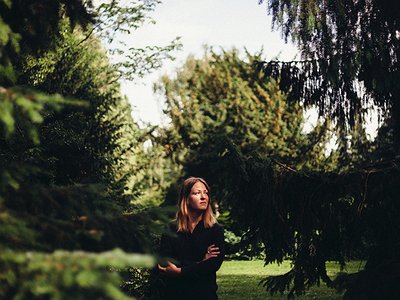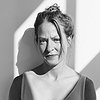Part 2
Could you describe your creative process on the basis of a piece or album that's particularly dear to you, please? Where did the ideas come from, how were they transformed in your mind, what did you start with and how do you refine these beginnings into the finished work of art?
My album The Enterer is built up as a compositional suite that circulates around the first piece that was made, called “Ginst”. Each track emphasises and develops elements and motives from “Ginst” into small worlds of their own. This was also the very first piece that I composed when studying an advanced course in electroacoustic composition two years ago at Malmö Academy of Music. Several of the ideas that I use in this piece actually started as a home assignment for the course.
I started by recording a set of different instruments at home; my baroque viola, recorder, claves and small cymbals that you attach and play with your fingers. It was a random choice of instruments but this was what I could bring home easily to try out and experiment with. For me it wasn’t that important at the time what the samples would source from, but I wanted to experiment and see the outcome when using totally new combinations of sounds. These recordings became more or less the whole sample library for the album. I remember that the first pick of choice, working with “Ginst”, was using a harmonic from the viola into a little melodic theme, that also constitutes the general pace of the whole record. After that followed a string of software experiments with these samples that let me slowly improvise the material. The course exam assignment was to make a piece over 8 minutes duration, which would force you to into taking decisions in shaping its compositional form. These were also my main challenges, as I remember. One of my biggest lessons composing this piece was to learn how to get out of the box, to get away from the idea of where my logic would lead the path and repeat itself; a combination of pure play and silliness that would make me take myself a little less seriously, together with problem-solving. From this mind-set, I could jump into completely new places without thinking too much about how it would fit together, and in the next step, find bridges between parts. The remaining gaps almost fill themselves.
There are many descriptions of the ideal state of mind for being creative. What is it like for you? What supports this ideal state of mind and what are distractions? Are there strategies to enter into this state more easily?
Playfulness. Embracing your inner child, noticing and cherishing every little input and idea that comes up - it is almost like a meditation and a self-exploration journey. There are so many cultural rules and expectations that we let colour our world, both from others but mostly from ourselves, and that we learnt to live by to fit in. I train and try to get more and more aware of the spontaneous inputs, rather than always going for the safe choices that often come with analytical thinking.
If intuition says a bold and high pitch sound, it might not always be what I would have chosen to go with if I didn’t really pay attention and decide that this is the primary input I choose to listen to. With this comes a lot of trust of that I might know more than my conscious state of mind acknowledges at that moment. It takes full responsibility and a kind of different focus to be in this state of mind, so almost anything can become a distraction. The wish to control might be one of the biggest challenges - control of what I think of myself and/or what others think of me; and this takes practice. The more you listen, the more detailed the information gets. And then you can better trust that it will be exactly how it should be.
How is playing live and writing music in the studio connected? What do you achieve and draw from each experience personally? How do you see the relationship between improvisation and composition in this regard?
Personally, I like composing as if I were to improvise but at a very slow pace. I like to pay attention to what would be the next inputs and listen as if you heard the music for the first time. What sounds are there? All samples that I use have so far also been improvised when recording them. I like working with material that isn’t composed to fit in a certain way, but to create the structure afterwards. I usually work out the general structure of the music that I want to perform in my electroacoustic set beforehand, and find elements that I can improvise on stage.
How do you see the relationship between the 'sound' aspects of music and the 'composition' aspects? How do you work with sound and timbre to meet certain production ideas and in which way can certain sounds already take on compositional qualities?
I don’t consider abstract sounds as different from composition. Any kind of sound could outline the foundation for a composition. I see it as a matter of finding qualities in the sound to compose with and to use its special characteristics that can be emphasised into a structure. It could be a rhythmical motive or structure, a general shape. To give an example, I used the sound of a cup falling as the main motive for a piece, which in the end, consisted of a white noise. The same sound source is used later on, but processed differently, to give the composition a general sound that glues it together. In its sound properties, I hear many different pitches and rhythms which I find interesting and strong in character. Typically, I work with the most detailed sounds first, before I add any kind of bass or textural effects.
Our sense of hearing shares intriguing connections to other senses. From your experience, what are some of the most inspiring overlaps between different senses - and what do they tell us about the way our senses work? What happens to sound at its outermost borders?
Since I was a child I have seen colours and patterns as an inner picture to almost anything. It could be a person’s character, seeing the same person’s name spelled out, musical pitches, timbres, textures, or any other kind of impression. Since we cannot imagine what someone else’s thought structure might be like, or how others “see”, I imagined that this was how everyone perceived the world.
Now I believe that we all have our individual way of perceiving impressions, depending on which senses are inherited to be emphasised, or trained from how we pay attention to them. For some, it could be experienced through vision, smell, or a very tactile sense, but with music I do think many have in common a sense of bodily experience, since sound waves directly approach our physical body. Some pitches or sounds hit our body and trigger different feelings connected to the physical experience. Some sounds could be experienced as purely beautiful and some might provoke. Like this, music could have a healing effect.
What I think is even more interesting to investigate is sharing the experience with other musicians and an audience through empathy. I use to get the most touched by music when it gave me an experience directly from the heart, which says that all is in all; I am a part of everything and everything is a part of me. There is no separation. Emelie Cajsdotter described the concept of empathy so beautifully: “You experience the other and see yourself. You gain an ability to see yourself from the outside and experience the other from the inside. What we usually assume is that I see the other from the outside and only experience my own experience of the other. If you get sad, I know how it feels in me that you get sad, but I know how it feels in you when you get sad, then it's empathy”. This, I think, is one of the greatest gifts that music provides.
Art can be a purpose in its own right, but it can also directly feed back into everyday life, take on a social and political role and lead to more engagement. Can you describe your approach to art and being an artist?
I see frustrations, both politically and in society, tracking our origins back to the same source, making humanity separated as a species from the rest of living life. Music as an element to share and coexist within, can therefore be reflected both as a political or socially engaged role, but with a more fundamental nature. It is also obvious that culture will be the least prioritised by politics in our society as it looks today, since it calls on us to function hand in hand in a bigger picture - the classic clash between dominance and coexistence.
It is remarkable, in a way, that we have arrived in the 21st century with the basic concept of music still intact. Do you have a vision of music, an idea of what music could be beyond its current form?
Music is a special art form as its expression is created in this moment and in every next moment it will be new - a direct channel of the present state. This state is a reminder of openness in the heart and to welcome transformation as one of life’s fundamental pillars. A creative and abstract channel in which to share without selection or compromise of words, which I think is a necessary complement to the spoken language we use to communicate through.






